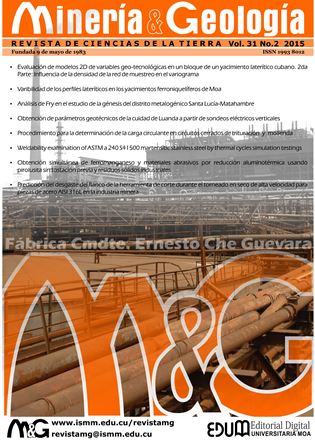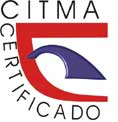Predicción del desgaste del flanco de la herramienta de corte durante el torneado en seco de alta velocidad para piezas de acero AISI 316L en la industria minera
Palabras clave:
Torneado de alta velocidad, desgaste de flanco, acero inoxidable AISI 316L, estudio experimental, análisis de varianza y regresión.Resumen
Se realizó un estudio experimental sobre la influencia de los parámetros de corte en el torneado del acero inoxidable AISI 316L con insertos recubiertos de TiCN, Al2O3, TiN. Un microscopio electrónico de barrido fue utilizado para medir y analizar el desgaste de las herramientas de corte. Los resultados fueron comparados utilizando el análisis de varianza y el análisis de regresión múltiple para describir la relación entre el desgaste del flanco de las herramientas de corte, el tiempo de maquinado y el avance de corte, obteniéndose las ecuaciones de los modelos ajustados. La investigación demostró el efecto significativo del avance y del tiempo de maquinado en el desgaste del flanco. El inserto de tres capas no sobrepasó el criterio de fin de vida del desgaste, mientras que el inserto de una capa sufrió un desgaste elevado para la mayor velocidad de corte. El desgaste del flanco tuvo mejor comportamiento para el avance de 0,08 mm/rev en todas las velocidades empleadas en este estudio. Los errores medios absolutos no superaron el 15 %.Descargas
Citas
ASILTÜRK, I. & ÇUNKA, M. 2011: Modeling and prediction of surface roughness in turning operations using artificial neural network and multiple regression method. Expert Systems with Applications 38(5): 5 826–5 832.
BARTARYA, G. & CHOUDHURY, S. K. 2012: State of the art in hard turning. International Journal of Machine Tools and Manufacture 53(1): 1-14.
CIFTCI, I. 2006: Machining of austenitic stainless steels using CVD multi-layer coated cemented carbide tools. Tribology International 39(6): 565-569.
CORDES, S. E. 2012: Thermal stability of γ-alumina PVD coatings and analysis of their performance in machining of austenitic stainless steels. CIRP Journal of Manufacturing Science and Technology 5(1): 20-25.
GAITONDE, V.; KARNIK, S.; SIDDESWARAPPA, B. & ACHYUTHA, B. 2008: Integrating Box-Behnken design with genetic algorithm to determine the optimal parametric combination for minimizing burr size in drilling of AISI 316L stainless steel. The International Journal of Advanced Manufacturing Technology 37(3): 230-240.
GALANIS, N. & MANOLAKOS, D. 2010: Surface roughness prediction in turning of femoral head. The International Journal of Advanced Manufacturing Technology 51(1): 79-86.
GERTH, J.; GUSTAVSSON, F.; COLLIN, M.; ANDERSSON, G.; NORDH, L. G.; HEINRICHS, J. & WIKLUND, U. 2014: Adhesion phenomena in the secondary shear zone in turning of austenitic stainless steel and carbon steel. Journal of Materials Processing Technology 214(8): 1 467-1 481.
HERNÁNDEZ, L. W.; PÉREZ, R.; ZAMBRANO, P.; GUERRERO, M. & DUMITRESCU, P. 2011: Estudio del desgaste del flanco de carburos recubiertos y cermet durante el torneado de alta velocidad en seco del acero AISI 1045. Revista de Metalurgia 47(3): 262-272.
JIANXIN, D.; JIANTOU, Z.; HUI, Z. & PEI, Y. 2011: Wear mechanisms of cemented carbide tools in dry cutting of precipitation hardening semi-austenitic stainless steels. Wear 270(7–8): 520-527.
JIAO, Y.; LEI, S.; PEI, Z. J. & LEE, E. S. 2004: Fuzzy adaptive networks in machining process modeling: surface roughness prediction for turning operations. International Journal of Machine Tools & Manufacture 44(15): 1 643–1 651.
KORKUT, I.; KASAP, M.; CIFTCI, I. & SEKER, U. 2004: Determination of optimum cutting parameters during machining of AISI 304 austenitic stainless steel. Materials & Design 25(4): 303-305.
LASTRES, M.; CORDOVÉS, A. & ARZOLA, J. 2010: Distribución y corte de piezas irregulares con anidamiento bidimensional en la industria minera. Minería y Geología 26(3): 48-67.
LEPPERT, T. & PENG, R. 2012: Residual stresses in surface layer after dry and MQL turning of AISI 316L steel. Production Engineering 6(4): 367-374.
LIN, H. M. 2008: The study of high speed fine turning of austenitic stainless steel. Journal of Achievements in Materials and Manufacturing Engineering 27(2): 191-194.
MAHDAVINEJAD, R. & SAEEDY, S. 2011: Investigation of the influential parameters of machining of AISI 304 stainless steel. Sadhana 36(6): 963-970.
NAVES, V. T. G.; DA SILVA, M. B. & DA SILVA, F. J. 2013: Evaluation of the effect of application of cutting fluid at high pressure on tool wear during turning operation of AISI 316 austenitic stainless steel. Wear 302(1–2): 1 201-1 208.
SURESH, R.; BASAVARAJAPPA, S.; GAITONDE, V. N. & SAMUEL, G. L. 2012: Machinability investigations on hardened AISI 4340 steel using coated carbide insert. International Journal of Refractory Metals and Hard Materials 33: 75-86.
SURESH, R.; BASAVARAJAPPA, S. & SAMUEL, G. L. 2012: Some studies on hard turning of AISI 4340 steel using multilayer coated carbide tool. Measurement 45(7): 1 872-1 884.
XAVIOR, M. A. & ADITHAN, M. 2009: Determining the influence of cutting fluids on tool wear and surface roughness during turning of AISI 304 austenitic stainless steel. Journal of Materials Processing Technology 209(2): 900-909.
Publicado
Cómo citar
Número
Sección
Los autores que publican en esta revista están de acuerdo con los siguientes términos:
- Licencia Creative Commons Atribución-NoComercial permite que el beneficiario de la licencia tenga el derecho de copiar, distribuir, exhibir y representar la obra y hacer obras derivadas para fines no comerciales siempre y cuando reconozca y cite la obra de la forma especificada por el autor o el licenciante.
- Los autores pueden establecer por separado acuerdos adicionales para la distribución no exclusiva de la versión de la obra publicada en la revista (por ejemplo, situarlo en un repositorio institucional o publicarlo en un libro), con un reconocimiento de su publicación inicial en esta revista.
- Se permite y se anima a los autores a difundir sus trabajos electrónicamente (por ejemplo, en repositorios institucionales o en su propio sitio web) antes y durante el proceso de envío, ya que puede dar lugar a intercambios productivos, así como a una citación más temprana y mayor de los trabajos publicados (Véase The Effect of Open Access) (en inglés).
- Lo anterior debe realizarse siempre sobre el artículo ya publicado por Minería y Geología.
La revista permite que los autores tengan los derechos de autor sin restricciones
La revista permite que los autores conserven los derechos de publicación sin restricciones










